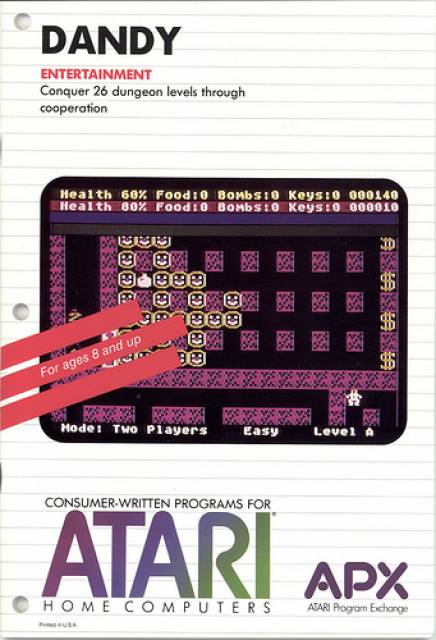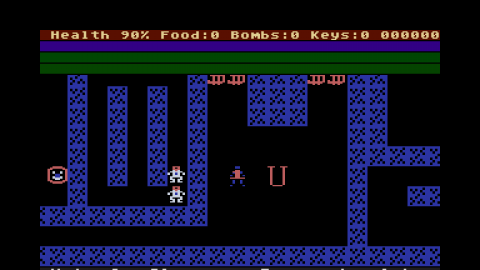Overview
Dandy, an early dungeon crawling game originally created as part of the Atari Program eXchange, is cited by many as the unofficial inspiration for Gauntlet.
Written by John Palevich, this game was submitted to the Atari Program eXchange, a subsidiary of the Atari Corporation which accepted original works from contributing users who programmed for the 8-Bit Atari systems. This version was released in 1983. Gauntlet was later produced by Atari corporation, bearing several striking similarities to Palevich's game. When confronted, Atari refused to give Palevich in-game credit despite their pleading no contest to his indirect influence in the creation of the game due to the ROMs of the game already having been created, though he was compensated with, of all things, a Gauntlet arcade machine. Palevich later sold the right to produce the game to other developers for release on systems such as the Commodore 64. Palevich would go on to produce a similar game called Dark Chambers, commissioned by Atari.
Similarities to Gauntlet
Dandy supports simultaneous play for up to 4 players. It is a dungeon crawl with levels of monsters to kill, which degrade as they are hit with the player character's 8-direction ranged attacks. Players can accumulate potion-shaped bombs which clear the screen of enemies or shoot them to activate them instantly, just like the magic potions in Gauntlet. Food is also collected, as in Gauntlet, to stave of loss of health, and monsters are created using monster generators, just like in Gauntlet. Players also must collect keys to advance through the dungeon, collect treasure for score, and must exit to the next lower level through portals in the floor.
Differences
Included standard in the original version of Dandy was a level editor, where players could create their own dungeons. Food in the game could be held instead of expending it right away when walking over it as in Gauntlet, and health did not creep toward zero as in Gauntlet, possibly due to Gauntlet being an arcade game designed to encourage players to insert more coins. Monster behavior in Dandy is uniform, and when shooting a monster to downgrade it to a lower-order enemy, it cycles through various pictures, but all of the creatures are basically the same type of monster which closes in on the player character. Players in Dandy could collect an item called a heart of gold, which could revive dead party members, although this may have been removed from later versions of the game for balance reasons.
In Gauntlet, there was was some random generation of the next maze characters entered, preventing a rote memorization of patterns. Melee attacks were now possible in Gauntlet, and all the characters in Gauntlet have different levels of abilities.
Conclusion
It could be said that Dandy should be recognized as the historic precursor to Gauntlet, as all the signs are there for the direct influence of Dandy on the later Gauntlet. It should also be recognized that some reasonable upgrades to the engine were added by Ed Logg and company. So while the creation of Gauntlet without giving Palevich credit was unscrupulous, Gauntlet's design improvements represented a subtle evolution of the groundwork that Palevich laid down.
It is an unfortunate side-effect of Palevich's sale of the rights of Dandy to other parties that leads some to believe Dandy was made after Gauntlet, due to the new developers' release of Dandy after Gauntlet was released, despite Gauntlet having come out significantly later than the 8-Bit version of Dandy.


 Amstrad CPC
Amstrad CPC
